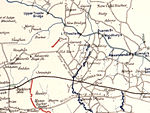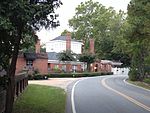Battle of Fair Oaks & Darbytown Road
The Battle of Fair Oaks & Darbytown Road (also known as the Second Battle of Fair Oaks) was fought October 27–28, 1864 in Henrico County, Virginia, as part of the Richmond-Petersburg Campaign of the American Civil War. In combination with movements against the Boydton Plank Road at Petersburg, Maj. Gen. Benjamin Butler attacked the Richmond defenses along Darbytown Road with the X Corps. The XVIII Corps marched north to Fair Oaks where it was soundly repulsed by Maj. Gen. Charles W. Field's Confederate division. Confederate forces counterattacked, taking some 600 prisoners. The Richmond defenses remained intact. Of Lt. Gen. Ulysses S. Grant's offensives north of the James River, this was repulsed most easily. The Medal of Honor was awarded to First Lieutenant William Rufus Shafter for his actions. Union casualties were 1,603, Confederates fewer than 100.
Excerpt from the Wikipedia article Battle of Fair Oaks & Darbytown Road (License: CC BY-SA 3.0, Authors).Battle of Fair Oaks & Darbytown Road
Charles City Road,
Geographical coordinates (GPS) Address Nearby Places Show on map
Geographical coordinates (GPS)
| Latitude | Longitude |
|---|---|
| N 37.494 ° | E -77.334 ° |
Address
Charles City Road 3105
23231
Virginia, United States
Open on Google Maps







